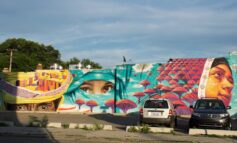
|
| Iyyad Sabbah’s sculptures in the Shejaiya district of Gaza City. |
GAZA CITY — Among the mountains of rubble littering Gaza after a deadly summer war, clay outlines emerge of men, women and children with a story to tell about fear, flight and destruction.
Through his sculptures, which are made of fiberglass and covered with clay, Iyyad Sabbah relates the pain of those who lived through this latest conflict with Israel during which nearly 2,200 Palestinians were killed, mostly civilians.
Some are splashed with blood-red paint, those closest to the ruins of homes flattened by bombs in Gaza City’s eastern Shejaiya district.
The neighborhood, on the border with Israel, lay on the frontline when ground troops went in and was largely reduced to a wasteland in the war launched to halt cross-border militant rocket fire.
It is in Shejaiya that Sabbah, a professor of art at Gaza’s Al-Aqsa University, has chosen to locate his installation, attracting many passers-by.
“These statues recall the war, when we fled – men, women and children – some in just their underwear,” reflected Mohammed al-Latif, 20, who escaped his home shortly before it was flattened in an Israeli drone strike.
“These statues are a new form of art by giving form to the suffering of Gazans,” said the artist, who was delighted at the warm reception local people have given to his figures of clay.
Wary of hostility from conservative Muslims opposed to his depiction of the human form, he was happy to see dozens of adults and children crowding round for a closer look at his work.
Among the sculptures is a barefooted woman, her features barely discernible, carrying a naked child. Next to her is an old man leaning on a cain, a disheveled little boy in his arms.
Not everybody gets it.
“It’s very nice, but why set up these statues here, in the place where the Israelis bombed us?” asked Salah al-Khissi on his way to school.
“With this project I am speaking about people’s flight from their homes during the war,” explained Sabbah. “I’m trying to shine a spotlight on the crimes which the Israelis committed here.”
He added that this form of art is unfamiliar to Gazans, expressing hope that the installation might also have a therapeutic effect.
“We must treat the human aspect, take care of Palestinians who have been psychologically destroyed and whose society has collapsed,” Sabbah said.
To drive home this idea of fragility and collapse, Sabbah also deconstructs his subjects.
Seen from the front, they look almost alive.
But from behind, you can a see their hollow frames and cracked clay, metaphors, he said, for the “disintegration of society and the flagrant attacks on Palestinian rights.”
With these statues, which put a face on suffering, he also hopes to “send a message to Israel that it has destroyed the humanity of Gazans by destroying their homes and their infrastructure.”
For Mohammed Muslim, also a professor of art at the university, Sabbah’s works are certainly a reminder of the war, but at the same time, they “express a dynamic.”
“Families have left and need help to return to a normal life,” he said.
But two months after the war ended, practically no building material has entered Gaza due to Israel’s ongoing blockade.
With more than 100,000 homes damaged in the 50-day conflict, affecting a third of Gaza’s population of 1.8 million, a return to normality looks far off.
Gaza has been subjected to a stringent Israeli blockade since 2006, with construction materials tightly controlled for fear militants could make use of them to forge arms or build fortifications.
“Politicians all talk about the reconstruction of Gaza and the physical destruction,” Sabbah said. “But I would like them to turn their attention to the damage caused at the human level, where we’re talking about a psychological crisis affecting all Gazans.”
-Middle East Online





Leave a Reply